A 6 inch f/18 Refractor
Made for a Unique Lens Rescued from Obscurity
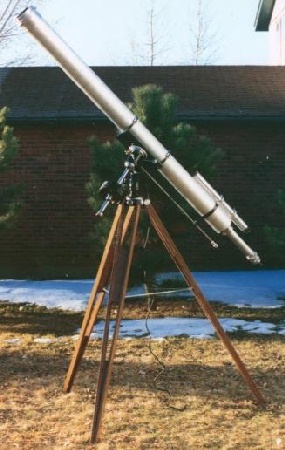

As I understand it, this telescope's objective lens was made in a prison camp near Crossville, Tennessee by a German prisoner of war during World War 2. The original telescope's tube was made from 16 to 20 slats of wood, round on the outside, and the lens cell was made of plywood. The tube would break down into three sections. The mount was fashioned from what appeared to be a large brake drum from a truck and was driven by a roller on the inside track of the drum. The focuser was wood and the Ramsden eyepieces were handmade of brazed brass tubes.
After the war, the telescope saw service at a school observatory for many years and was subsequently purchased in the 1970's by a pastor and boy scout leader who used it to introduce many people to the wonders of the sky . The lens was coated at some point prior to his acquisition. There is a brownish tint to the glass.
After more years had passed the telescope became unuseable. The eyepieces and brass parts found their way into other projects and the lens in it's cell languished in dusty storage. I acquired the lens and wooden cell in a "horse trade" in the 1990's. With a 9 foot focal length, I had to think twice before committing to construction of this telescope, but with it's unique history I eventually decided the project was worth the effort.
In the spirit of the German amateur telescope maker that made the lens and it's original telescope, I committed to build the new telescope entirely from home made parts and/or scrap items. The castings were all poured in my front yard with homemade foundry equipment and the machine work was all done on my home made lathe and home made band saw. (I did use a commercially built drill press though.)
The main tube is thick walled aluminum (scrounged from a scrap yard) and contains 11 light baffles, 6 of which are installed inside the draw tube for maximum contrast. The baffling was designed to provide a fully illuminated 3/4 inch diameter field when the draw tube is fully extended, and a 1/2 inch diameter fully illuminated field when the draw tube is fully retracted. The draw tube has 10.5 inches of travel providing plenty of room for any accessory that may come to hand. No vignetting or reduction of the field is encountered until the tube is 3.5 inches from the fully retracted position.The draw tube is made from thick-walled 2.5 inch tubing which originally came from a scrap metal yard and saw service for many years as one leg of a short tripod mount for the first good Newtonian telescope I built - a 10 inch f/5.6 in the mid 1970's. The draw tube slides smoothly on four wide teflon rings recessed into the inner diameter of the tailpiece casting and is made very firm and steady by a second tailpiece section about 6 inches up the inside of the main tube.
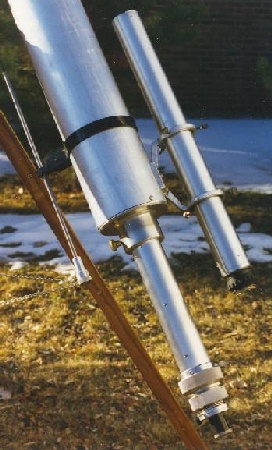
The finderscope is made from a 2 inch f/11 achromat liberated from a surplus missle tracking sight, combined with a hefty military surplus Erfle eyepiece in a fully baffled aluminum tube that results in a wide, crisp, high contrast view. This little finder scope is actually one of my favorite telescopes in it's own right.
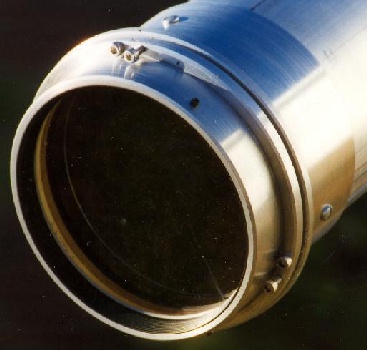
The aluminum lens cell is fully adjustable with 3 pairs of stainless steel push-pull screws. The castings for this cell were the first successful castings made on my "metal casting learning curve". A second cell of brass was poured, but the weight of the brass castings quickly convinced me that aluminum would be the much better choice.
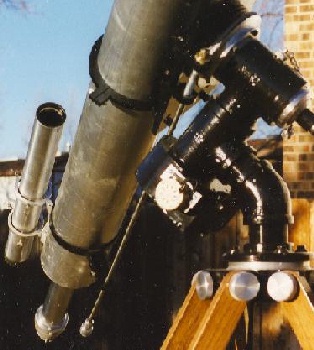
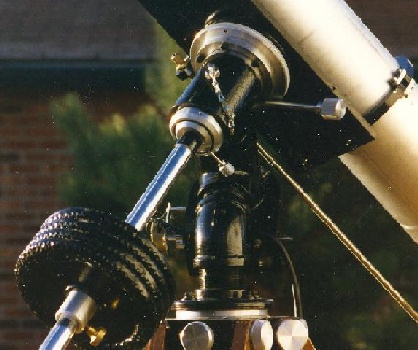
The mount was made from pipe fittings and is fitted with four ball bearings that were liberated from a radar unit. The polar axis is fitted with a home made 359 tooth worm wheel and adjustable pressure plate style slip clutch for the siderial drive. The AC synchronous timing motor was taken from an old clothes dryer, and the chrome plated counterweight shaft was removed from an old printer. The counterweights are part of what remains from a barbell set that was abandoned in a neighbor's backyard when he moved away. A stiff wire brush and a coat of "Rustoleum" paint enabled them to live a new life.
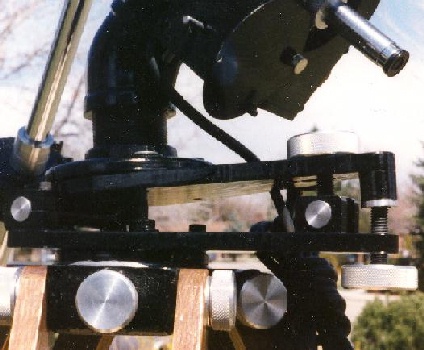
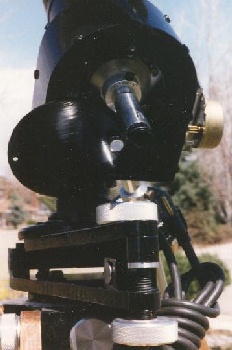
Access to the clutch pressure adjustment is made via an access panel on the back of the drive housing that rotates out of the way by loosening one thumbscrew. This also allows insertion of a small crosshair equipped telescope into the polar axis for polar alignment.
The base of the mount is fixed to the top of a pair of thick aluminum plates, the upper of which tilts via a pair of 1/2 inch push-pull screws for lattitude adjustment. The lower plate is fixed to a cast aluminum cylinder that rotates in the tripod head for azimuth adjustment. Recessed into the bottom of this cylinder is a pair of AA batteries with a switch and a bright red LED to illuminate the tripod's accessory shelf.
The declination axis is drilled for the alignment scope's light path as is the pipe tee that forms the housing for the declination axis, which is fitted with a threaded cap to keep out dust and moisture when not in use. The cap is chained to the mount to prevent loss in the dark. The declination axis is fitted with a 360 tooth wormwheel for slow motion. This provides one degree of movement per turn of the control which is extended to the eyepiece end of the telescope by a removable length of 3/8 inch stainless steel tubing. A bracket made from 1 inch aluminum band clamps to the main tube and keeps this control rod in place.
The tripod head is a solid aluminum casting and the tripod legs are made from red oak which was glued and screwed together then stained and overcoated with a thick clear finish. A similarly finished plywood accessory shelf serves double duty as a leg brace. There are three thick aluminum bars screwed to the underside of the tray. These attach to the legs with three more of the same 1/2 inch screws that hold the legs to the tripod head. All of the screws used in set up and take down are fitted with large knurled aluminum knobs so no tools are necessary in the field.
The telescope itself provides good images with round symetrical diffraction rings around star's Airy disks. It does well for solar observation and I used it to videotape the transit of Mercury across the sun's face in 1999(?). Views of globular clusters are crisp and contrasty and from a dark site two dust lanes in M31 are easily seen. However, since the telescope is so long and cumbersome, it rarely gets to go to a dark site and is most often used in town for solar/lunar/planetary viewing. The tube length also makes long tripod legs necessary for viewing the zenith. This results in fairly long vibration damping times. This vibration damping issue would probably be resolved if the telescope were mounted on a permanent pier, but I currently have no area at home with a wide enough view of the sky to justify installing such a pier. For this reason the mount is most often used at remote sites on a shorter but otherwise identical tripod with a 3 inch refractor for piggyback photography and solar observing.
In lieu of a permanent home for the telescope, current plans are to use it in a horizontal position with a heliostat to feed a spectrohelioscope. Some day I hope to mount it on a permanent pier as refractors of this size were intended.
This was a fun and rewarding project that gave new life to a lens with a very unique history.
- Jim Sapp